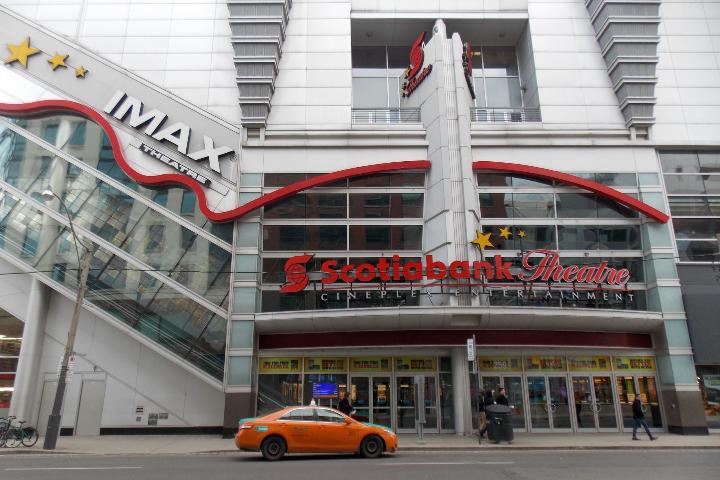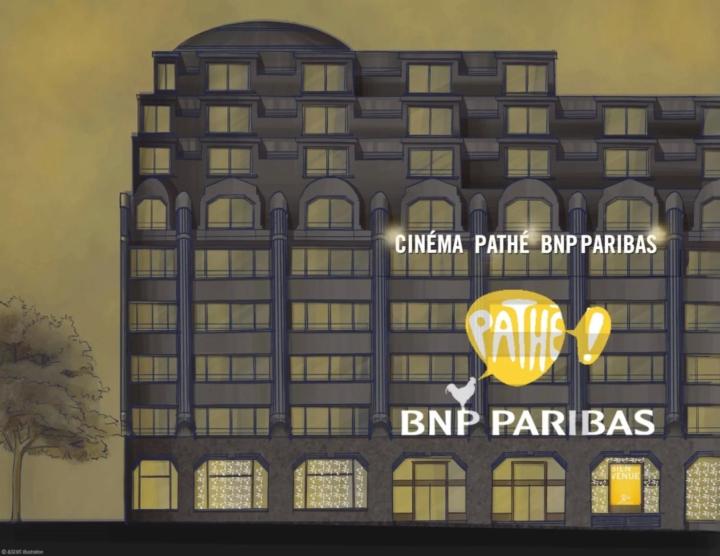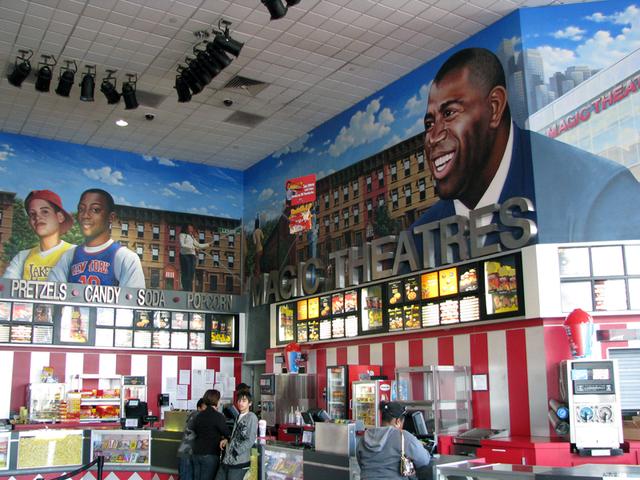As cinemas seek to diversify and look for new income streams, there is the prospect of taking a leaf from the sporting world and giving corporate sponsors naming rights. This was highlighted by the recent opening of a Pathé BNP Paribas cinema in Paris's 2nd arrondissement. So, with major brands already advertising on the big screen in cinemas all across the world, should they go further and actually put their name on the cinema itself? There are some interesting examples already, but do they make a case for a wider adoption of this practice? .
Corporate naming rights have long been established in sports venues. From the Allianz and Emirates Stadiums in London to the T-Mobile Center (formerly Sprint Center) in downtown Kansas City, Missouri, corporate sponsors can be integral to funding major sporting venues. The motivation for corporations engaging in these agreements include enhancing brand visibility, associating with positive consumer experiences, and reaching target demographics, while venue operators in turn benefit from substantial revenue streams that support operations and development. This is also not just confined to sports but wider multi-use venues, such as the Co-op Live entertainment arena, located in Manchester, which recently opened (after last minute delays) and is the UK's largest.
This model is now also slowly finding traction in the cinema industry. Recent examples show a growing trend toward cinema venues becoming open to corporate sponsors in their names, at least for select venues.

Global Examples of Cinema Partnerships
In the heart of Hollywood, the iconic TCL Chinese Theatre stands as one of the world's most recognisable cinema landmarks. But many visitors may not realise that its name represents one of the most prominent examples of corporate branding in cinema history. In 2013, the historic Grauman's Chinese Theatre entered into a 10-year naming rights partnership with TCL Corporation (renewed in 2023), a major Chinese electronics manufacturer, in a deal worth over USD $5 million. The partnership facilitated several upgrades and preservation projects, including new seating, a digital marquee, lobby refurbishments, and technology enhancements, aimed at restoring the theatre to its original grandeur, which the venue operator might otherwise have struggled to finance.
The banking sector has been particularly active in cinema naming rights. In France, the recently reopened and rebranded Pathé BNP Paribas cinema (formerly Pathé Opéra Premier) in Paris's 2nd arrondissement marks "the first time in France" a cinema has borne the name of a private company outside the sector. This five-screen, 440-seat venue maintains Pathé's graphic identity while incorporating BNP Paribas visual elements, providing a high-end marquee for the bank just minutes from its historic headquarters.
In Canada, there is already the Scotiabank Theatre chain (French: Cinémas Banque Scotia), named after the Canadian bank, with ten cinema locations across Canada. The brand dates back to 2007, when it was launched as part of a wider partnership between Cineplex and Scotiabank on their new Scene loyalty program. This demonstrates the potential for a successful long-term partnership model between cinema chains and corporations, with Cineplex still having a profile in the sub-set of the branding.
In addition to banks, soft drinks and beverage companies have also established cinema branding in several locations. The Apollo Kino Coca-Cola Plaza in Estonia is perhaps the first and best known example; an entertainment complex built specifically for movie screenings. With its 11 movie auditoriums, it has been one of the biggest and and highest grossing multiplexes in all three Baltic states since it opened in 2001.
In Asia, CGV theatres are also associated with Coca-Cola, extending the beverage giant's cinema presence globally. In 2023 Coca-Cola and CGV Cinemas unveiled a Coca-Cola 'Reborn Area' at five CGV Cinemas locations in Jakarta, as part of the soft-drink giant’s effort to promote sustainability and recycling.
It is not just Coke who is working closely to associate its name and brand with cinemas. Forum Cinemas' biggest Premium auditorium in Latvia has been renamed PEPSI and presents the biggest cinema screen with Barco 4K projection, Dolby Atmos sound system, and what it claims to be the largest capacity among all movie theatres in the Baltic states. One suspects that the rivalry between both the drinks and cinema brands has spurred these naming partnerships.

Benefits for Both Partners
For corporations, these partnerships offer valuable marketing opportunities. Elise Hermant, director of communications at BNP Paribas, noted their cinema partnership was "a good opportunity for our brand image, directly visible on the street, in the heart of our neighbourhood." Meanwhile, for cinema operators, corporate sponsorships provide crucial revenue streams. Already many cinemas work with corporations for things such as using cinemas as day-time conference venues, group outings or reward for staff and other form of engagement that monetises multiplexes in more ways than just selling tickets to regular goers, with concessions and advertising on top.
There are also ticket discounting, promos or two-for-one brand tie-ins such as Sky Cinema, Mubi Go and Meerkat Movies in the UK, where there is the added incentive of customer data collection and insights to benefit both parties.
Brands can further capitalise on cinema partnerships by creating memorable experiences to complement their on-screen advertising. As Mike Hope-Milne, Enterprise Director at Pearl & Dean, notes in an article in Creative Brief, "Unlike other forms of advertising, people plan to go to the screenings and expect to see advertising as part of the experience; it's an event they look forward to and they're often going to be in a receptive mood." There is thus brand positivity to be had in cinemas, particularly when it comes the most premium venues.
The most successful partnerships feature natural alignments between the film experience and the brand. Food or drink brands make sense to accompany the theatrics of a film, but brands can think creatively about how the link is made; for example, providing branded blankets or rugs for people to snuggle up underneath during the showing, or having a section of the cinema dedicated to the brand. This was the case in Metro Manila (Philippines), where the New Frontier Theater was renamed "Kia Theatre" after the cinema’s parent company signed a licensing deal with Columbian Autocar Corporation, the Philippine distributor for Kia Motors, running from 2015 until 2018, on July 15, 2015. Under the terms of the deal, the cinema featured a 305.96 m2 (3,293.3 sq ft) Kia showroom, as well as the Kia name on the facade and throughout the venue.
HeyCar, an online automotive marketplace, sponsored the UK’s Luna Cinema at Christmas; because what better place to advertise cars, than at a drive-in where many guests will be motorists? Consumers are known to be more receptive when the sponsorship feels organic, rather than just tacked on. With consumer electronics brands such as Samsung and LG moving into the cinema display field, there will no doubt be more opportunities for corporate branding and promotion on and off the ‘silver’ or LED screen.

Internal Branding vs Corporate Sponsorship
While corporate naming deals for entire cinemas are growing, many cinema chains tend to focus instead on building their own strong brands. Major chains like B&B Theatres and Vue as well as more boutique ones like Everyman and Curzon have invested heavily in their own brand identities. These try to set themselves apart from their competitors, as much as from the home-viewing experience.
Major cinema chains in the US, such as AMC Theatres and Cinemark Theatres, utilise their own internal branding strategies across their numerous locations. Following its acquisition of Carmike Cinemas, AMC began to unify its cinemas under three main banners: AMC, AMC Classic, and AMC Dine-In, each offering a distinct movie-going experience with varying amenities.
Similarly, Cinemark operates theaters under several brands, including its flagship Cinemark, as well as Century Theatres, Tinseltown, CinéArts, and Rave Cinemas. Furthermore, AMC has introduced "XL at AMC" auditoriums, which are branded as the largest non-premium large format auditoriums within their theaters. These internal brands help cinemas differentiate their offerings without relying on external corporate partners.
B&B Theatres meanwhile has the Sterling’s in-house hospitality brand, where customers can come to eat even if they have not come to watch a film. In the UK, Joe's Food Truck and the Beer & Cocktail Van are available exclusively at Omniplex Birmingham and Wigan, with plans to expand to more locations in the future, as cinemas seek to distinguish their quick-serve food profiles from those of other operators in their immediate catchment area – so while you might see a Starbucks corner in a Cineworld multiplex, don’t expect a Five Guys to take the place of Everyman’s Spielburger.
While not directly a corporate brand or tie-in, there is the “AMC Magic Johnson Theatres” sub-brand by AMC Theatres. A certain well-known celebrity brand can specifically target certain demographics and enhance the appeal of these cinema locations, as AMC does with various sites in underserved communities in the US.
The Real Star Power
Despite the growth in corporate branding, the most powerful brands in the cinema experience often remain the films themselves and their stars. Blockbuster franchises, beloved characters, and celebrity actors continue to be the primary draw for audiences, whether it is “A Minecraft Movie” or the latest Tom Cruise blockbuster. Corporate brands might want some of the red carpet glitz, but they are not the reason why cinema goers turn up to buy tickets.
Premium Large Format (PLF) cinemas, like Riga’s PEPSI-branded auditorium, are in many ways the most natural fit for corporate brands. This is because of their enhanced visual and audio quality, as well as overall comfort, which provide audiences with the most captivating and enjoyable viewing environment. It is thus not surprising that it’s been popular for sites, such as the now-closed Pepsi IMAX Theatre, which was located on the top floor of the Trocadero Centre building in London.
Corporate branding in cinemas represents a growing opportunity for revenue generation and partnership, but it remains balanced against the cinemas' own branding efforts and, most importantly, the magnetic pull of the films themselves. So, while banks, soft drinks, automobiles and consumer electronics will want associations with some premium cinema venues, we should not expect to see airlines, telecom operators and insurers plastering their name across the largest cinema stadiums just yet.
Gold for the Silver Screen – Should Corporate Sponsors Brand Cinemas?